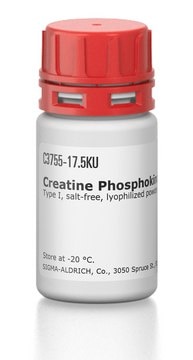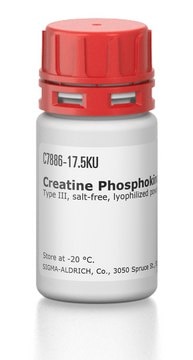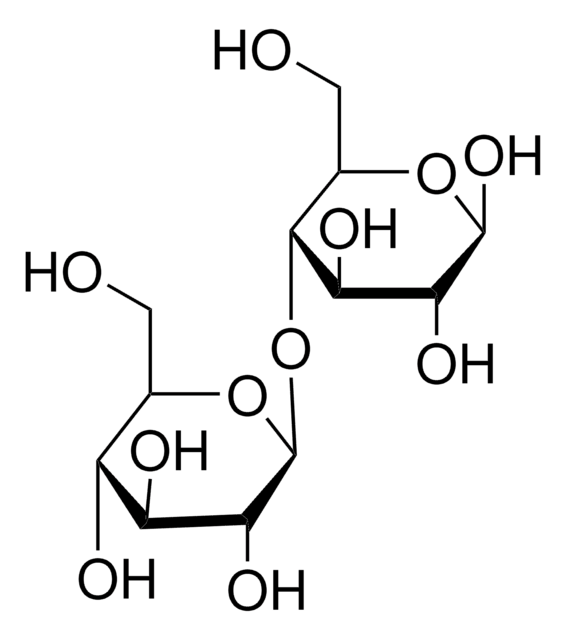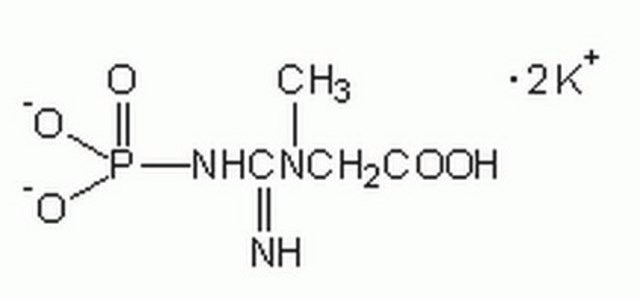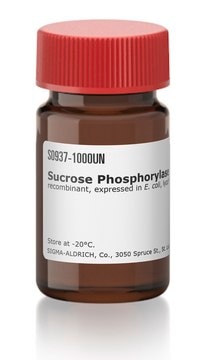CK-RO
Roche
Creatine Kinase (CK)
from rabbit muscle
Synonym(s):
creatine phosphokinase
About This Item
Recommended Products
biological source
rabbit muscle
Quality Level
form
lyophilized
specific activity
~350 units/mg protein (at 25 °C (800 U/mg lyophilizate at 37 °C) with creatine phosphate and ADP as the substrates, and N-acetyl-L-cysteine as the activator.)
packaging
pkg of 100 mg (10127566001)
pkg of 500 mg (10736988001)
manufacturer/tradename
Roche
color
white to light yellow
optimum pH
6.0-7.0(reverse reaction)
9.0(forward reaction)
solubility
water: soluble
suitability
suitable for immunoprecipitation
NCBI accession no.
UniProt accession no.
application(s)
life science and biopharma
sample preparation
foreign activity
ATPase <0.001%
HK <0.001%
myokinase <0.001%
storage temp.
2-8°C
Gene Information
rabbit ... CKM(100009056)
Related Categories
General description
Creatine kinase (CK) has a molar mass of 85kDa. It exists as a dimer in the cytosolic form and as a dimer and an octamer in the mitochondrial form. The cytosolic forms are named as MM, BB, and MB, where M and B correspond to muscle and brain, respectively. CK from rabbit muscle is a dimer containing two identical polypeptide chains of 380 amino acids. Each subunit has four cysteines, Cys73, Cys145, Cys253 and Cys282, but lacks inter- and intra-chain disulfide bonds.
Application
Biochem/physiol Actions
Quality
Specifications
Unit Definition
Physical form
Preparation Note
Dissolve in 0.1 M imidazole buffer; aliquot and store at -15 to -25 °C.
Stable for approximately four weeks at -15 to -25 °C.
Avoid repeated freezing and thawing.
Dissolve in 0.5% NaHCO3 solution.
Do not freeze. Store protected from light.
Stable for 2 - 3 days, when stored at 2 to 8 °C.
Or
Dissolve in 30 mM glycine buffer, pH 9.0, with 0.2 mM DTT.
Stable for 2 - 3 days, when stored at 2 to 8 °C.
Other Notes
Storage Class
11 - Combustible Solids
wgk_germany
WGK 1
flash_point_f
does not flash
flash_point_c
does not flash
Certificates of Analysis (COA)
Search for Certificates of Analysis (COA) by entering the products Lot/Batch Number. Lot and Batch Numbers can be found on a product’s label following the words ‘Lot’ or ‘Batch’.
Already Own This Product?
Find documentation for the products that you have recently purchased in the Document Library.
Customers Also Viewed
Our team of scientists has experience in all areas of research including Life Science, Material Science, Chemical Synthesis, Chromatography, Analytical and many others.
Contact Technical Service